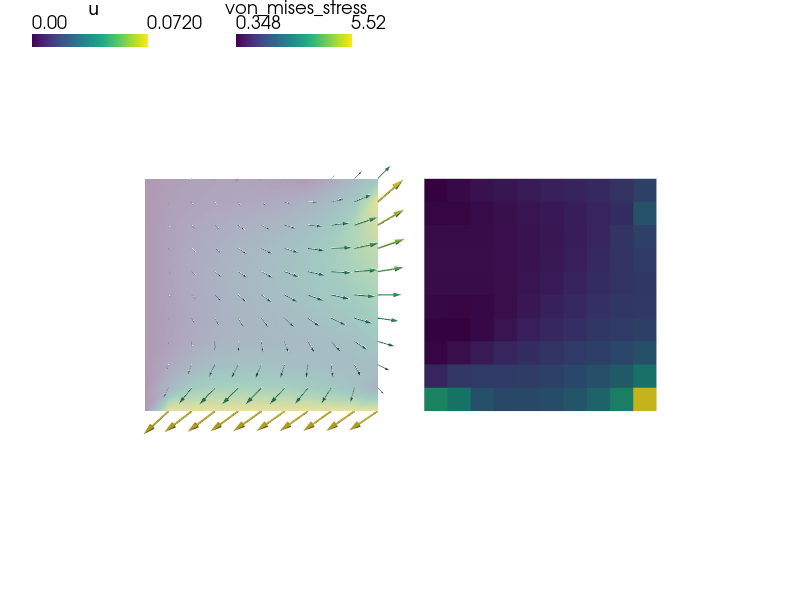linear_elasticity/nodal_lcbcs.py¶
Description
Linear elasticity with nodal linear combination constraints.
Find  such that:
such that:

where

and  with given
traction pressure
with given
traction pressure  . The constraints are given in terms of
coefficient matrices and right-hand sides, see the
. The constraints are given in terms of
coefficient matrices and right-hand sides, see the lcbcs keyword below. For
instance, 'nlcbc1' in the 3D mesh case corresponds to

that should hold in the 'Top' region.
This example demonstrates how to pass command line options to a problem
description file using --define option of sfepy-run. Try:
sfepy-run sfepy/examples/linear_elasticity/nodal_lcbcs.py --define='dim: 3'
to use a 3D mesh, instead of the default 2D mesh. The example also shows that the nodal constraints can be used in place of the Dirichlet boundary conditions. Try:
sfepy-run sfepy/examples/linear_elasticity/nodal_lcbcs.py --define='use_ebcs: False'
to replace ebcs with the 'nlcbc4' constraints. The results should be
the same for the two cases. Both options can be combined:
sfepy-run sfepy/examples/linear_elasticity/nodal_lcbcs.py --define='dim: 3, use_ebcs: False'
The post_process() function is used both to compute the von Mises
stress and to verify the linear combination constraints.
View the 2D results using:
sfepy-view square_quad.vtk -2
View the 3D results using:
sfepy-view cube_medium_tetra.vtk

r"""
Linear elasticity with nodal linear combination constraints.
Find :math:`\ul{u}` such that:
.. math::
\int_{\Omega} D_{ijkl}\ e_{ij}(\ul{v}) e_{kl}(\ul{u})
= - \int_{\Gamma_{right}} \ul{v} \cdot \ull{\sigma} \cdot \ul{n}
\;, \quad \forall \ul{v} \;,
where
.. math::
D_{ijkl} = \mu (\delta_{ik} \delta_{jl}+\delta_{il} \delta_{jk}) +
\lambda \ \delta_{ij} \delta_{kl}
\;.
and :math:`\ull{\sigma} \cdot \ul{n} = \bar{p} \ull{I} \cdot \ul{n}` with given
traction pressure :math:`\bar{p}`. The constraints are given in terms of
coefficient matrices and right-hand sides, see the ``lcbcs`` keyword below. For
instance, ``'nlcbc1'`` in the 3D mesh case corresponds to
.. math::
u_0 - u_1 + u_2 = 0 \\
u_0 + 0.5 u_1 + 0.1 u_2 = 0.05
that should hold in the ``'Top'`` region.
This example demonstrates how to pass command line options to a problem
description file using ``--define`` option of ``sfepy-run``. Try::
sfepy-run sfepy/examples/linear_elasticity/nodal_lcbcs.py --define='dim: 3'
to use a 3D mesh, instead of the default 2D mesh. The example also shows that
the nodal constraints can be used in place of the Dirichlet boundary
conditions. Try::
sfepy-run sfepy/examples/linear_elasticity/nodal_lcbcs.py --define='use_ebcs: False'
to replace ``ebcs`` with the ``'nlcbc4'`` constraints. The results should be
the same for the two cases. Both options can be combined::
sfepy-run sfepy/examples/linear_elasticity/nodal_lcbcs.py --define='dim: 3, use_ebcs: False'
The :func:`post_process()` function is used both to compute the von Mises
stress and to verify the linear combination constraints.
View the 2D results using::
sfepy-view square_quad.vtk -2
View the 3D results using::
sfepy-view cube_medium_tetra.vtk
"""
import numpy as nm
from sfepy.base.base import output, assert_
from sfepy.mechanics.matcoefs import stiffness_from_lame
from sfepy.mechanics.tensors import get_von_mises_stress
from sfepy import data_dir
def post_process(out, pb, state, extend=False):
"""
Calculate and output strain and stress for given displacements.
"""
from sfepy.base.base import Struct
ev = pb.evaluate
stress = ev('ev_cauchy_stress.2.Omega(m.D, u)', mode='el_avg')
vms = get_von_mises_stress(stress.squeeze())
vms.shape = (vms.shape[0], 1, 1, 1)
out['von_mises_stress'] = Struct(name='output_data', mode='cell',
data=vms, dofs=None)
dim = pb.domain.shape.dim
us = state().reshape((-1, dim))
field = pb.fields['displacement']
if dim == 2:
ii = field.get_dofs_in_region(pb.domain.regions['Top'])
output('top LCBC (u.0 - u.1 = 0):')
output('\n', nm.c_[us[ii], nm.diff(us[ii], 1)])
ii = field.get_dofs_in_region(pb.domain.regions['Bottom'])
output('bottom LCBC (u.0 + u.1 = -0.1):')
output('\n', nm.c_[us[ii], nm.sum(us[ii], 1)])
ii = field.get_dofs_in_region(pb.domain.regions['Right'])
output('right LCBC (u.0 + u.1 = linspace(0, 0.1)):')
output('\n', nm.c_[us[ii], nm.sum(us[ii], 1)])
else:
ii = field.get_dofs_in_region(pb.domain.regions['Top'])
output('top LCBC (u.0 - u.1 + u.2 = 0):')
output('\n', nm.c_[us[ii], us[ii, 0] - us[ii, 1] + us[ii, 2]])
output('top LCBC (u.0 + 0.5 u.1 + 0.1 u.2 = 0.05):')
output('\n', nm.c_[us[ii],
us[ii, 0] + 0.5 * us[ii, 1] + 0.1 * us[ii, 2]])
ii = field.get_dofs_in_region(pb.domain.regions['Bottom'])
output('bottom LCBC (u.2 - 0.1 u.1 = 0.2):')
output('\n', nm.c_[us[ii], us[ii, 2] - 0.1 * us[ii, 1]])
ii = field.get_dofs_in_region(pb.domain.regions['Right'])
output('right LCBC (u.0 + u.1 + u.2 = linspace(0, 0.1)):')
output('\n', nm.c_[us[ii], nm.sum(us[ii], 1)])
return out
def define(dim=2, use_ebcs=True):
assert_(dim in (2, 3))
if dim == 2:
filename_mesh = data_dir + '/meshes/2d/square_quad.mesh'
else:
filename_mesh = data_dir + '/meshes/3d/cube_medium_tetra.mesh'
options = {
'nls' : 'newton',
'ls' : 'ls',
'post_process_hook' : 'post_process'
}
def get_constraints(ts, coors, region=None):
mtx = nm.ones((coors.shape[0], 1, dim), dtype=nm.float64)
rhs = nm.arange(coors.shape[0], dtype=nm.float64)[:, None]
rhs *= 0.1 / (coors.shape[0] - 1)
return mtx, rhs
functions = {
'get_constraints' : (get_constraints,),
}
fields = {
'displacement': ('real', dim, 'Omega', 1),
}
materials = {
'm' : ({
'D' : stiffness_from_lame(dim, lam=5.769, mu=3.846),
},),
'load' : ({'val' : -1.0},),
}
variables = {
'u' : ('unknown field', 'displacement', 0),
'v' : ('test field', 'displacement', 'u'),
}
regions = {
'Omega' : 'all',
'Bottom' : ('vertices in (y < -0.499) -v r.Left', 'facet'),
'Top' : ('vertices in (y > 0.499) -v r.Left', 'facet'),
'Left' : ('vertices in (x < -0.499)', 'facet'),
'Right' : ('vertices in (x > 0.499) -v (r.Bottom +v r.Top)', 'facet'),
}
if dim == 2:
lcbcs = {
'nlcbc1' : ('Top', {'u.all' : None}, None, 'nodal_combination',
([[1.0, -1.0]], [0.0])),
'nlcbc2' : ('Bottom', {'u.all' : None}, None, 'nodal_combination',
([[1.0, 1.0]], [-0.1])),
'nlcbc3' : ('Right', {'u.all' : None}, None, 'nodal_combination',
'get_constraints'),
}
else:
lcbcs = {
'nlcbc1' : ('Top', {'u.all' : None}, None, 'nodal_combination',
([[1.0, -1.0, 1.0], [1.0, 0.5, 0.1]], [0.0, 0.05])),
'nlcbc2' : ('Bottom', {'u.[2,1]' : None}, None, 'nodal_combination',
([[1.0, -0.1]], [0.2])),
'nlcbc3' : ('Right', {'u.all' : None}, None, 'nodal_combination',
'get_constraints'),
}
if use_ebcs:
ebcs = {
'fix' : ('Left', {'u.all' : 0.0}),
}
else:
ebcs = {}
lcbcs.update({
'nlcbc4' : ('Left', {'u.all' : None}, None, 'nodal_combination',
(nm.eye(dim), nm.zeros(dim))),
})
equations = {
'elasticity' : """
dw_lin_elastic.2.Omega(m.D, v, u)
= -dw_surface_ltr.2.Right(load.val, v)
""",
}
solvers = {
'ls' : ('ls.scipy_direct', {}),
'newton' : ('nls.newton', {
'i_max' : 1,
'eps_a' : 1e-10,
}),
}
return locals()